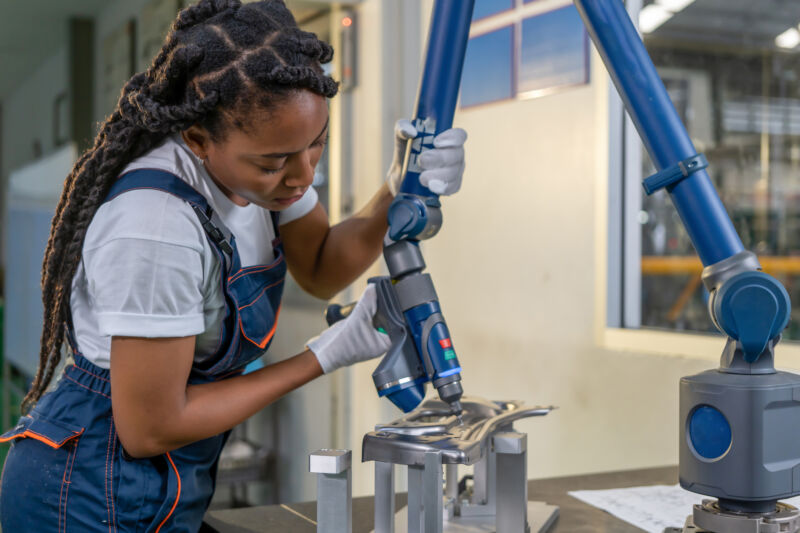Maximum Diffusion Reinforcement Learning focuses training on end states, not process.

Reinforcement-learning algorithms in systems like ChatGPT or Google’s Gemini can work wonders, but they usually need hundreds of thousands of shots at a task before they get good at it. That’s why it’s always been hard to transfer this performance to robots. You can’t let a self-driving car crash 3,000 times just so it can learn crashing is bad.
But now a team of researchers at Northwestern University may have found a way around it. “That is what we think is going to be transformative in the development of the embodied AI in the real world,” says Thomas Berrueta who led the development of the Maximum Diffusion Reinforcement Learning (MaxDiff RL), an algorithm tailored specifically for robots.
Introducing chaos
The problem with deploying most reinforcement-learning algorithms in robots starts with the built-in assumption that the data they learn from is independent and identically distributed. The independence, in this context, means the value of one variable does not depend on the value of another variable in the dataset—when you flip a coin two times, getting tails on the second attempt does not depend on the result of your first flip. Identical distribution means that the probability of seeing any specific outcome is the same. In the coin-flipping example, the probability of getting heads is the same as getting tails: 50 percent for each.
ADVERTISING
In virtual, disembodied systems, like YouTube recommendation algorithms, getting such data is easy because most of the time it meets these requirements right off the bat. “You have a bunch of users of a website, and you get data from one of them, and then you get data from another one. Most likely, those two users are not in the same household, they are not highly related to each other. They could be, but it is very unlikely,” says Todd Murphey, a professor of mechanical engineering at Northwestern.
The problem is that, if those two users were related to each other and were in the same household, it could be that the only reason one of them watched a video was that their housemate watched it and told them to watch it. This would violate the independence requirement and compromise the learning.
“In a robot, getting this independent, identically distributed data is not possible in general. You exist at a specific point in space and time when you are embodied, so your experiences have to be correlated in some way,” says Berrueta. To solve this, his team designed an algorithm that pushes robots be as randomly adventurous as possible to get the widest set of experiences to learn from.
Two flavors of entropy
The idea itself is not new. Nearly two decades ago, people in AI figured out algorithms, like Maximum Entropy Reinforcement Learning (MaxEnt RL), that worked by randomizing actions during training. “The hope was that when you take as diverse set of actions as possible, you will explore more varied sets of possible futures. The problem is that those actions do not exist in a vacuum,” Berrueta claims. Every action a robot takes has some kind of impact on its environment and on its own condition—disregarding those impacts completely often leads to trouble. To put it simply, an autonomous car that was teaching itself how to drive using this approach could elegantly park into your driveway but would be just as likely to hit a wall at full speed.
To solve this, Berrueta’s team moved away from maximizing the diversity of actions and went for maximizing the diversity of state changes. Robots powered by MaxDiff RL did not flail their robotic joints at random to see what that would do. Instead, they conceptualized goals like “can I reach this spot ahead of me” and then tried to figure out which actions would take them there safely.Advertisement
Berrueta and his colleagues achieved that through something called ergodicity, a mathematical concept that says that a point in a moving system will eventually visit all parts of the space that the system moves in. Basically, MaxDiff RL encouraged the robots to achieve every available state in their environment. And the results of first tests in simulated environments were quite surprising.
Racing pool noodles
“In reinforcement learning there are standard benchmarks that people run their algorithms on so we can have a good way of comparing different algorithms on a standard framework,” says Allison Pinosky, a researcher at Northwestern and co-author of the MaxDiff RL study. One of those benchmarks is a simulated swimmer: a three-link body resting on the ground in a viscous environment that needs to learn to swim as fast as possible in a certain direction.
In the swimmer test, MaxDiff RL outperformed two other state-of-the-art reinforcement learning algorithms (NN-MPPI and SAC). These two needed several resets to figure out how to move the swimmers. To complete the task, they were following a standard AI learning process divided down into a training phase where an algorithm goes through multiple failed attempts to slowly improve its performance, and a testing phase where it tries to perform the learned task. MaxDiff RL, by contrast, nailed it, immediately adapting its learned behaviors to the new task.
The earlier algorithms ended up failing to learn because they got stuck trying the same options and never progressing to where they could learn that alternatives work. “They experienced the same data repeatedly because they were locally doing certain actions, and they assumed that was all they could do and stopped learning,” Pinosky explains. MaxDiff RL, on the other hand, continued changing states, exploring, getting richer data to learn from, and finally succeeded. And because, by design, it seeks to achieve every possible state, it can potentially complete all possible tasks within an environment.
But does this mean we can take MaxDiff RL, upload it to a self-driving car, and let it out on the road to figure everything out on its own? Not really.
Flipped ants
The ability to explore all possible states brings robustness, adaptability, amazing sample efficiency, and many other things to the table. But it is not yet perfect.
The other test Berrueta’s team did with MaxDiff RL was the ant world test, where an algorithm is supposed to move a quadrupled ant from one side of the board to the other. The test is very similar to the swimmer except for one thing: The ant can incapacitate itself by flipping upside down. While MaxDiff RL walked the ant a longer distance than the other AIs, it also often managed to flip it.
“For computer science applications, the only thing that matters is that it succeeds most of the time. In robotics, one failure could be catastrophic,” says Murphey. According to the team, such irreversible states are common in the real world and happen due to mechanical failures or unsafe robot behaviors. So, to address that, Berrueta and his team plans to run MaxDiff RL on real, rather than simulated, robots in the future.
“One of those real robots is the swimmer. It is effectively a pool noodle that we cut up into three links and put some motors in between them, and we are going to try to use them to test out algorithm in the real world,” says Berrueta. “Another thing we are trying to do is figuring out single shot learning in the real world. We want to do this with a robot arm putting pegs in holes,” he adds.
“MaxDiff RL could also be used for stationary robots, like a robotic arm in a kitchen that learns how to load a dishwasher,” says Pinosky. “We know this is very difficult, so it’s a bit like, ‘I would love to do this, but I don’t know if this is the next step.’ But I do think it is something MaxDiff RL would be well suited to,” Pinosky adds.
Nature Machine Intelligence, 2024. DOI: 10.1038/s42256-024-00829-3




